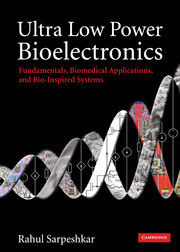Book contents
- Frontmatter
- Contents
- Acknowledgements
- Section I Foundations
- Section II Low-power analog and biomedical circuits
- 11 Low-power transimpedance amplifiers and photoreceptors
- 12 Low-power transconductance amplifiers and scaling laws for power in analog circuits
- 13 Low-power filters and resonators
- 14 Low-power current-mode circuits
- 15 Ultra-low-power and neuron-inspired analog-to-digital conversion for biomedical systems
- Section III Low-power RF and energy-harvesting circuits for biomedical systems
- Section IV Biomedical electronic systems
- Section V Principles for ultra-low-power analog and digital design
- Section VI Bio-inspired systems
- Section VII Energy sources
- Bibliography
- Index
- Epilogue
- References
11 - Low-power transimpedance amplifiers and photoreceptors
from Section II - Low-power analog and biomedical circuits
Published online by Cambridge University Press: 02 December 2010
- Frontmatter
- Contents
- Acknowledgements
- Section I Foundations
- Section II Low-power analog and biomedical circuits
- 11 Low-power transimpedance amplifiers and photoreceptors
- 12 Low-power transconductance amplifiers and scaling laws for power in analog circuits
- 13 Low-power filters and resonators
- 14 Low-power current-mode circuits
- 15 Ultra-low-power and neuron-inspired analog-to-digital conversion for biomedical systems
- Section III Low-power RF and energy-harvesting circuits for biomedical systems
- Section IV Biomedical electronic systems
- Section V Principles for ultra-low-power analog and digital design
- Section VI Bio-inspired systems
- Section VII Energy sources
- Bibliography
- Index
- Epilogue
- References
Summary
In the study of this membrane [the retina] … I felt more profoundly than in any other subject of study the shuddering sensation of the unfathomable mystery of life.
Santiago Ramón y CajalWith this chapter, we begin our study of circuits by understanding a classic feedback topology used to sense currents and convert them into voltage, i.e., transimpedance amplifiers. Transimpedance amplifiers are widely used in several sensor and communication applications including microphone preamplifiers, amperometric molecular and chemical sensors, patch-clamp amplifiers in biological experiments, photoreceptors for optical communication links, barcode scanners, medical pulse oximeters for oxygen-saturation measurements, and current-to-voltage conversion within and between chips. After a brief introduction to transimpedance amplifiers, we shall focus on a specific application, i.e., the creation of a photoreceptor, a transimpedance amplifier for sensing photocurrents on a chip. The photoreceptor example will serve as a good vehicle for concretely illuminating several issues that are typical in sensors and transimpedance-amplifier design. It will also serve as a good application for illustrating how the fundamentals of device physics, feedback systems, and noise affect the operation of real circuits and systems.
The photoreceptor discussed here was inspired by the operation of photoreceptors in turtle cones and was first described in [1]. A photoreceptor similar to the one described in this chapter is used to create the low-power pulse oximeter described in Chapter 20 and in [2]. The photodiode basics described here are also useful in understanding how low-power imagers (see Chapter 19) and solar cells (see Chapter 26) work.
- Type
- Chapter
- Information
- Ultra Low Power BioelectronicsFundamentals, Biomedical Applications, and Bio-Inspired Systems, pp. 275 - 300Publisher: Cambridge University PressPrint publication year: 2010



